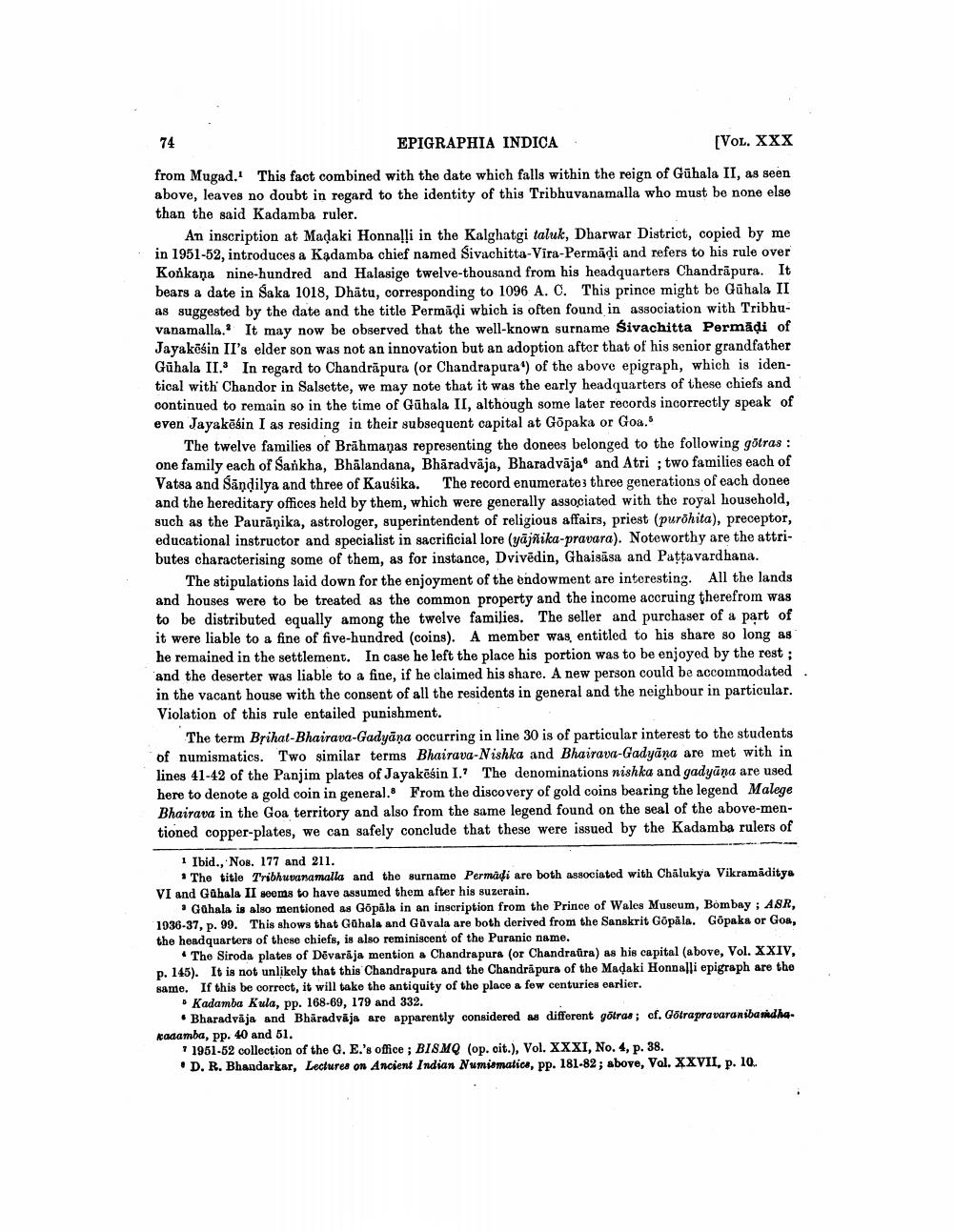________________
EPIGRAPHIA INDICA
[VOL. XXX from Mugad. This fact combined with the date which falls within the reign of Gühala II, as seen above, leaves no doubt in regard to the identity of this Tribhuvanamalla who must be none else than the said Kadamba ruler.
An inscription at Madaki Honnalli in the Kalghatgi taluk, Dharwar District, copied by me in 1951-52, introduces a Kadamba chief named Sivachitta-Vira-Permādi and refers to his rule over Konkana nine-hundred and Halasige twelve-thousand from his headquarters Chandrāpura. It bears a date in Saka 1018, Dhātu, corresponding to 1096 A. C. This prince might be Gūhala II as suggested by the date and the title Permādi which is often found in association with Tribhuvanamalla. It may now be observed that the well-known surname Sivachitta Permādi of Jayakośin II's elder son was not an innovation but an adoption after that of his senior grandfather Gūhala II. In regard to Chandrapura (or Chandrapura) of the above epigraph, which is identical with Chandor in Salsette, we may note that it was the early headquarters of these chiefs and continued to remain so in the time of Gūhala II, although some later records incorrectly speak of even Jayakēģin I as residing in their subsequent capital at Göpaka or Goa.
The twelve families of Brāhmaṇas representing the donees belonged to the following götras : one family each of Sankha, Bhālandana, Bhäradvāja, Bharadvāja® and Atri ; two families each of Vatsa and Sandilya and three of Kausika. The record enumerates three generations of each donee and the hereditary offices held by them, which were generally associated with the royal household, such as the Paurānika, astrologer, superintendent of religious affairs, priest (purohita), preceptor, educational instructor and specialist in sacrificial lore (yājsika-pravara). Noteworthy are the attributes characterising some of them, as for instance, Dvivēdin, Ghaisāsa and Pattavardhana.
The stipulations laid down for the enjoyment of the endowment are interesting. All the lands and houses were to be treated as the common property and the income accruing therefrom was to be distributed equally among the twelve families. The seller and purchaser of a part of it were liable to a fine of five-hundred (coins). A member was, entitled to his share so long as he remained in the settlement. In case he left the place his portion was to be enjoyed by the rest : and the deserter was liable to a fine, if he claimed his share. A new person could be accommodated in the vacant house with the consent of all the residents in general and the neighbour in particular. Violation of this rule entailed punishment.
The term Brihat-Bhairava-Gadyāņa occurring in line 30 is of particular interest to the students of numismatics. Two similar terms Bhairava-Nishka and Bhairava-Gadyāņa are met with in lines 41-42 of the Panjim plates of Jayakësin I.: The denominations nishka and gadyāņa are used here to denote a gold coin in general. From the discovery of gold coins bearing the legend Malege Bhairava in the Goa territory and also from the same legend found on the seal of the above-mentioned copper-plates, we can safely conclude that these were issued by the Kadamba rulers of
1 Ibid., Nos. 177 and 211.
* The title Tribhuvanamalla and the surname Permadi aro both associated with Chalukya Vikramaditya VI and Gahala II seems to have assumed them after his suzerain.
• Gühala is also mentioned as Gopāla in an inscription from the Prince of Wales Museum, Bombay ; ASR, 1936-37, p. 99. This shows that Gühala and Gävala are both derived from the Sanskrit Gopāla. Göpaka or Goa, the headquarters of these chiefs, is also reminiscent of the Puranic name.
• The Siroda plates of Dövarája mention Chandrapura (or Chandraira) as his capital (above, Vol. XXIV, p. 145). It is not unlikely that this Chandrapura and the Chandrapura of the Madaki Honnalli epigraph are the same. If this be correct, it will take the antiquity of the place a fow centuries earlier.
Kadamba Kula, pp. 168-69, 179 and 332
• Bharadvāja and Bhäradvāja are apparently considered as different götras; cf. Götra pravaranibandhakadamba, pp. 40 and 51.
* 1951-52 collection of the G. E.'s office ; BISMQ (op. cit.), Vol. XXXI, No. 4, p. 38. . D. R. Bhandarkar, Lectures on Ancient Indian Numismatica, pp. 181-82; above, Vol. XXVII, p. 10.




